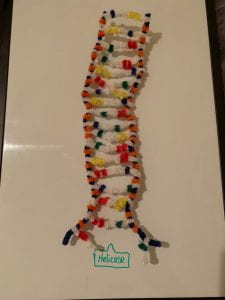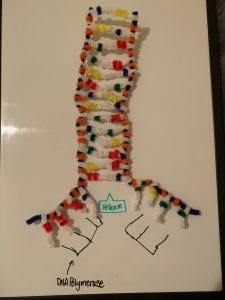AP12 – Pipecleaner DNA –
The structure of DNA:
DNA (deoxyribonucleic acid) is found in the nucleus of eukaryotes and the cytosol of prokaryotes, and is made up of a chain of repeating subunits (of monomers), called nucleotides. In each nucleotide, there are three main parts: a phosphate group, a sugar, and a nitrogenous base.

These phosphate groups are what make the DNA (nucleic acid) an acid. Attached to the phosphate groups, are a cycle / ring structured molecule, which is a five-carbon sugar. These alternating phosphate and sugar groups along the sides of DNA are its backbone. While these backbones seem to run parallel to each other, one is in fact the pointing in a different direction (upside down – the left strand is 5’ (prime) to 3’, and the right strand is 3’ to 5’, all on the five-carbon sugars) than the other, thus causing it to be antiparallel. [as shown below]

The five-carbon sugar which would be a Ribose sugar in RNA, becomes a Deoxyribose sugar in DNA, as it contains a hydrogen atom instead of a hydroxyl atom on its two-prime carbon (deoxyribo). The final part of the DNA structure, are the nitrogenous bases. Nitrogenous bases are classified into two different groups: purines and pyrimidines. The two-ringed bases are purines, whereas the one-ringed bases are pyrimidines. Within purines and pyrimidines are four different types of bases. In purines there is adenine, and guanine. In pyrimidines there is thymine, and cytosine. Adenine will always bond with thymine, and guanine with cytosine. This is referred to as complementary base pairing. As pyrimidine will always bond with a purine, it causes DNA to form a spiral / helix, and due to DNA being double stranded, its structure is therefore referred to as double helix.

How modeling DNA structure out of pipecleaners can be helpful:
For me, this activity helped to break down both the structure of DNA and the processes that occur to achieve this structure. The steps in which DNA functions became more clear, however I found that it could have been more useful to use two different colored bonded pipe cleaners to represent the two strands of DNA, instead of beads to represent the 5-carbon sugars. If we could have possibly used blue and orange pipe cleaner pieces connected together to form a DNA strand, then I would have found more clarity in what the beads were supposed to represent. Contrarily, I found that the use of beads as complimentary bases to improve my understanding of how their pairing works greatly, and I am now able to better remember what purines and pyrimidines pair together, and their differences as bases.

When does DNA replication occur?
DNA replication occurs during the synthesis phase of interphase and the mitotic phase of a eukaryotic cell. Interphase is a part of the cell cycle, which will cause DNA will go through three stages of change: first gap (G1), synthesis (S), and second gap (G2). Both the G1 and G2 phase together are recognized as interphase. During the G1 phase, the cell will physically grow larger, copy its organelles, and create molecular building blocks. Next, during the S phase, the cell will synthesize a copy of the DNA in its nucleus, while also duplicating the centrosome (helps separate DNA during mitotic phase). Following this process is the G2 phase, which causes the cell to further grow, creates proteins as well as organelles. Once this phase ends, the mitotic phase will occur. Here, the cell will divide the copied DNA and cytoplasm, thus creating two new cells. Within the mitotic phase, there are two existing processes: mitosis and cytokinesis. Four different stages exist within mitosis: prophase, metaphase, anaphase, and telophase. After both processes have taken place, then the DNA replication will have finished, and is dependent to the cell it is replicating, as to when the next daughter cell will be created.
The steps of DNA replication:
Some of the key components to DNA replication are enzymes, helicase, DNA polymerase, primase, ligase Enzymes are able to speed up reactions as well as build up or break down the items that they act upon.
Beginning at the origin, Helicase is able to “unzip” / unwind the two strands of DNA, by breaking the hydrogen bonds that attach the nitrogenous bases (adenine, thymine, cytosine, guanine). While this process occurs, single stranded binding proteins (SSB proteins) will bind to the separated DNA strands in order to prevent them from coming back together. During this process, topoisomerase will also control the DNA to prevent it from supercoiling (over winding of the DNA). DNA polymerase is then able to replicate DNA molecules in order to build the new strand of DNA, however it is unable to work without a primer. This primer (made up of RNA) is created by primase, which directs DNA polymerase to the point where it should begin to work on both strands of the DNA.
Why the steps of DNA replication occur differently in leading and lagging strands?
DNA polymerase will build the new strand of DNA in the 5’ to 3’ direction, and as DNA strands are antiparallel (left is 3’ to 5’, and right is 5’ to 3’), DNA polymerase will build the left 3’ to 5’ strand smoothly moving forward, while building on the 5’ to 3’ strand will force it to move from right to left, thus having to jump to the newest un-winded right (5’) section, and causing primers to continually be placed at the newest starting point, in order to continue building the DNA.

These two strands are categorized as leading (3’ to 5’), and lagging (5’ to 3’). After DNA polymerase has occurred in lagging strands, it will result in fragmentation between each 3’ 5’ section where it had to jump to the newest un-winded point. These are known as Okazaki fragments. As the primase primers are made up of RNA, ligase is then used to “glue” the gaps between Okazaki fragments, using nucleic bases to seal them. This entire process results in two identical DNA molecules, both being composed of old and new synthesized strands, which can be referred to as a semi-conservative process.
How replicating DNA with pipecleaners could be helpful:
With this activity, to represent complimentary base pairing along with the joining of adjacent nucleotides, I used a DNA strand, and un-winded the H-bonds that bonded the nucleic base acids, and demonstrated the both the helicase and DNA polymerase through drawing around the strand of DNA. This process was accurate in the steps that take place throughout the process of DNA replication, however it was not visually demonstrative in the process.

I found it hard to demonstrate the leading and lagging strands being copied (including the fragments that are created throughout this process on the lagging strand, along with demonstrating the primase that will seal them). While I also found it difficult to properly show the helicase breaking the seal, I think that drawing it going through the DNA strand helped to clarify the process further.







